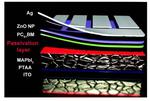Other

“Origami, traditionally associated with paper folding, has transcended its craft origins to influence a diverse range of fields, including art, science, engineering, and architecture. Recently, origami principles have extended to technology, with applications spanning solar cells to biomedical devices. While …

“A research team, led by Professor Joonki Suh in the Department of Materials Science and Engineering and the Graduate School of Semiconductor Materials and Devices Engineering at UNIST, has made a significant breakthrough in thin film deposition technology. By employing …
News New Study Unveils Vertically Oriented 2D Ruddlesden–Popper Phase Perovskite Passivation Layer for Efficient and Stable Inverted PSCs

“Their findings have been published in the August 2022 issue of Energy & Environmental Science (ESS, IF = 39.714). A research team, led by Professor Hyesung Park in the Department of Materials Science and Engineering at UNIST has succeeded in manufacturing …

“The work by Distinguished Professor Bartosz A. Grzybowski was published online and will be included in the October 2022 issue of Nature Physics. Historically, contact electrification (CE) was humanity’s first and only source of electricity up until ca. 18th …
“A joint research team, affiliated with UNIST has announced that they have successfully developed a thermoelectric technology to produce power-generating tubes using 3D printing techniques. Researchers found that the tube-shaped device is more effective than conventional devices. This breakthrough has …

“Researchers from UNIST have discovered a novel high-efficiency thermoelectric material that are intrinsically self-healable and highly stretchable. Their findings paved the way for discovery and development of smart clothes that harvest power from human body heat. A reasearch team, jointly …

“Their findings have been published in Energy & Environmental Science on May 20, 2020. A new rechargeable battery that can be charged wirelessly using light from indoor sources, like desk lamps has been developed. This will enable the so-called ‘Energy Recycling …

“A research team, led by Professor Hyesung Park in the School of Energy and Chemical Engineering at UNIST has unveiled a flexible metal grid-based hybrid electrode platform by using a Cu grid-embedded polyimide (CEP) film with a graphene sheet as …

“A novel technology that can improve the efficiency of quantum dot solar cells to 11.53% has been unveiled. Published in the February 2020 issue of Advanced Energy Materials, it has been evaluated as a study that solved the challenges …

“Metal-Air Batteries (MABs), which use oxygen from ambient air as recourses to store and convert energy, have received considerable attention for their potential use in electric vehicles (EVs) owing to their large storage capacity, lightweight, and affordability. A research team …

